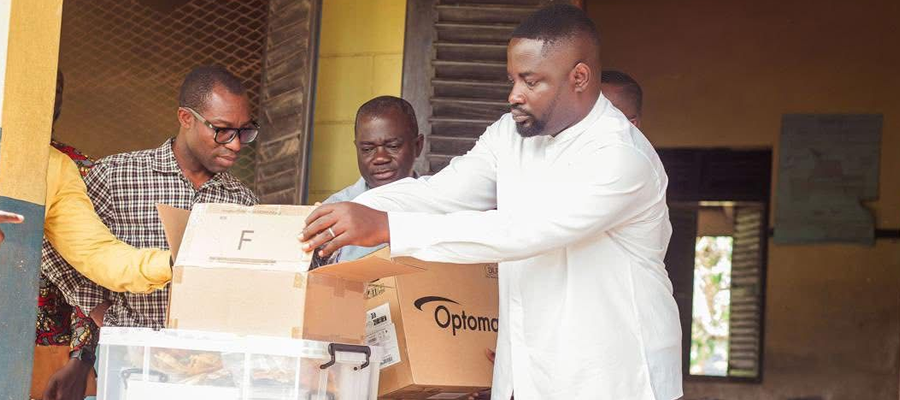

Location and Size
Size 1,090 square kilometres
Location
The Birim Central Municipal is one of the 17 administrative districts in the eastern region of Ghana Carved out of the former Birim Council in 1987 as part of the government’s decentralization programme the municipal shares boundaries with Birim North and Kwaebibirem (to the north) Adansi South and Assin North (West). Asikuma-Odoben-Brakwa and Agona West Municipal (South) and West Akim Municipal (East).Thus the Municipality especially, the capital Oda is linked up with many districts and this promote commercial activities among the district capitals and other nearby communities.
Topology and Drainage
The municipal is mostly undulating and hilly, and lies within the semi-deciduous forest zone. The underlying rock formation is mainly made up of the Upper Birimian rocks.The topography of the Birim Central Municipal is hilly, consisting of lava flows and schist.The municipal is drained by the Birim River and its major tributaries. Which, in some cases rise to 61 metres above sea level.
Climate & Vegetation
Climate
The municipal falls within the wet semi-equatorial climatic zone which experiences substantial amount of precipitation/rainfall. This season with rainfall between 150cm and 200cm reaching its maximum during the two peak periods of May-June and September-October.This promotes serious farming activities within these two periods i.e. May-June and September-October.Relative humidity of about 56% (dry season) and 70% of (raining season) between 25.2°C and 27.5°C create a relatively good atmosphere for socio-economic activities like trade and farming in dry season and rainy season respectively.It is sad to note however that there is occasional flooding in some communities during the two peak period of the raining season.
Vegetation
The Municipality falls within the semi-deciduous rain forest region leading to high degree of rainfall for crop cultivation and human use. The vegetation is mainly characterized by tall trees with evergreen undergrowth and bounced in economic tress.Most of the larger trees among others are Triplochition scleroxylon (Wawa), Antaris Africana (Kyenkyen), Clorophora Excelsa (Odum) Ceiba Pentandra (Onyina) are now few occurring as scattered emergent.These species serve as a source of raw materials to the timber industries in the Municipality which generate a lot of employment and income for the people in the municipality.Human activities such as poor farming practices lumbering (especially chain saw and firewood operations ), mining, construction works have had negative impact on the vegetation over the years resulting in scattered parcels of secondary forest.
The following are the major forest reserves in the Municipality;
Bemu Block 1 9.6sqkm
Bemu Block 11 13.18sqkm
Bemu Block 111 20.90sqkm
Birim 39.29sqkm
Birim Extension 21.48sqkm
Esen Epam 45.19sqkm
Esuboni 26.70sqkm
Pra-Birim North 14.34sqkm
Geology & Soil
Geology
The Built environment deals with the human settlements, other built up areas and man-made activities. Akim Oda and Akim Swedru which are the most urbanized settlements are confronted with the problem of haphazard and uncontrolled development, poor sanitation, poor waste management and poor housing, vehicular-pedestrian conflicts and poor infrastructure.There is also large quantities of plastics found in the refuse of most settlements which makes decomposition difficult hence pose serious aesthetic problems.
Housing problems in the municipal as it is common with most settlements in Ghana, is rather of quality and not quantity because of once booming economy when the diamond mining and cocoa industries were at their peak. In terms of disaster management, the buildings in the communities are properly built within terraces. However, the people’s enlightenment in disaster preparedness is not very encouraging. The man-made disasters include bushfire, domestic fire, road traffic accidents and epidemics such as cholera, typhoid fever, HIVAIDS etc. Disaster Management Committees have been at all the levels charged with the responsibility of preparing plans for preventing and mitigating disaster situations in the municipal.
Soil
1. Greyish brown loaming soils overlying red clay soils that occur at lower elevations of sloping hills
soil capability: Tree and arable crops especially cocoa farming.
2. Grey alluvial sand of thin layers
Soil capability: Dry season vegetables, sweet potato, sugar cane and rice cultivation.
1. Course sandy to fine gravelly topsoil and red coarse sandy subsoil.
Soil capability: Dry season vegetables, sweet potato and rice production.
1. Red soil developed over lower Biriman rocks and
2. Silty day loams soils which occupy fairy-extensive flat lands adjacent to streams and rivers.
Soil Capability: Both features have the potential for cocoa, coffee, citrus, oil palm, avocado pear, mangoes, banana and mechanized rice irrigation farming.
1. Moderately slow internal flow to medium surface run off. Moderately permeable and good moisture retention capacity.
Soil Capability: Wide range of free and arable crops.
2. Very deep pale brown or yellowish brown fine sand.
Soil Capability: Nurseries and vegetable production.
Date Created : 11/29/2017 5:32:56 AM













 facebook
facebook
 twitter
twitter
 Youtube
Youtube
 +233 593 831 280
+233 593 831 280 0800 430 430
0800 430 430 GPS: GE-231-4383
GPS: GE-231-4383 info@ghanadistricts.com
info@ghanadistricts.com Box GP1044, Accra, Ghana
Box GP1044, Accra, Ghana